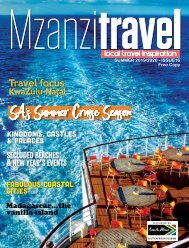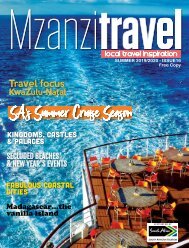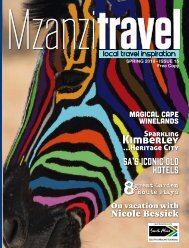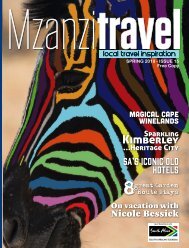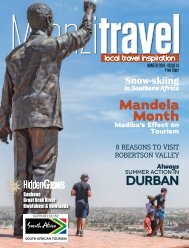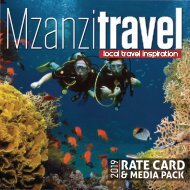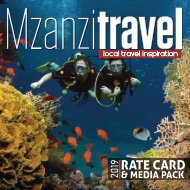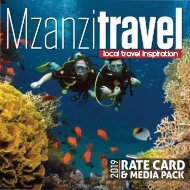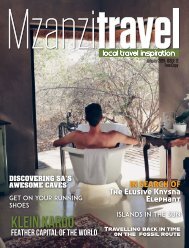Mzanzitravel Magazine - Issue 9
MzanziTravel Magazine is a local travel inspiration for tourists (local and international) to discover the best places to visit in Africa.
MzanziTravel Magazine is a local travel inspiration for tourists (local and international) to discover the best places to visit in Africa.
You also want an ePaper? Increase the reach of your titles
YUMPU automatically turns print PDFs into web optimized ePapers that Google loves.
SWAKOPMUND AND THE LIVING DESERT<br />
Around Swakopmund there are many delightful discoveries to be made. Spend<br />
a day in the huge sand dunes of the Namib Desert between the town and its<br />
southern neighbour Walvis Bay with a knowledgeable local guide, and you will<br />
quickly see what first appeared as mere dead mountains of sand, revealing its<br />
stunning and diverse life. Seldom receiving more than a couple of millimetres of<br />
rain in a year, if any at all, the oldest and most extreme desert in the world is home<br />
to an abundance of small creatures and plants, sustained by the life-giving fog that<br />
regularly rolls in across the thousands of kilometres of sand.<br />
Many of the unusual species of plants and animals that are found in this desert<br />
are endemic and highly adapted to the specific climate and conditions of the area.<br />
Throughout the desert there are tiny shrubs and plants, as well as the curious<br />
welwitchias that dot the desert landscape, some of them well over a thousand<br />
years old. In the coastal dunes the vegetation is smaller and sparser. Yet under or<br />
near these life-giving plants that hold the desert’s water supplies, you will find all<br />
manner of creatures.<br />
Closer to the coast they are mostly desert-adapted anthropods, reptiles and birds,<br />
including scorpions, spiders, chameleons, lizards, geckos and snakes such as the<br />
side winder or Peringuey’s adder, the Namib sand snake and the horned adder.<br />
These snakes usually lie buried under the sand, with only their eyes sticking out,<br />
and only a much trained human eye will spot them before it might be too late.<br />
Further inland the desert is also home to larger species, such as ostriches, oryx<br />
and springboks. The oryx have adapted to the harsh living conditions of the desert<br />
by being able to raise their body temperatures to 40°C (104°F) or even more, which<br />
allows them to sweat less and thus prevents loss of water through perspiration.<br />
Swakopmund, with its colourful mix of old German colonial and modern<br />
architecture, is bristling with busy shops and small malls, restaurants, pubs,<br />
hotels, cake shops, and galleries. Its beachfront is popular with locals and tourists<br />
alike.<br />
Travel inland along the highway to the capital of Windhoek or following the course<br />
of the dry Swakop River bed – which seldom bears water – and you will come<br />
across a number of uranium mines. Sticking to the dry river bed, you will find the<br />
ghostly ruins of an abandoned colonial-era railway station, the tracks long gone,<br />
as well as an eerie, abandoned old mining town known as Khan Mine. Further<br />
along you will come upon a vast ragged, blackened moon landscape popular with<br />
film companies. And beyond this lie the plains that are home to the welwitchias.<br />
The landscape on either side of the river is an ever changing one, with a diversity<br />
of weird and wonderful rock formations, hills and distant mountains. Along the<br />
river bed, near the Moon Landscape, a true little oasis suddenly appears: the<br />
Goanikontes Oasis Rest Camp with restaurant, farm house veranda, home baked<br />
cake and coffee, bungalows and chalets, and camping sites. There are other more<br />
basic camping sites along the river, but these consist of little more than a sandy<br />
patch with a couple of thorn trees, a basic toilet facility and some trash bins.



